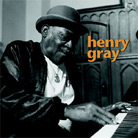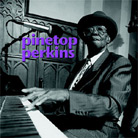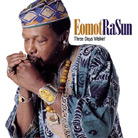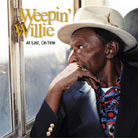![[SoundStage!]](../sslogo3.gif) The Vinyl Word The Vinyl WordBack Issue Article |
June 2002 Found on Vinyl: The Blues on Analogue Productions Originals What do you get when you combine equal parts audiophilia, business sense and a love of music? Well, if your name is Chad Kassem you get Analogue Productions, the end result of a lot of hard work on the part of a dedicated audiophile and music lover. As of today, Kassem’s empire consists of Acoustic Sounds, his audiophile CD/LP/SCAD/DVD-A mail-order company (call (800) 716-3553 to get their latest catalog); Blue Heaven Recording Studios in Salina, Kansas; and his record label, Analogue Productions Originals. Noticing that there was a real dearth of sonically superior blues records and that the few surviving bluesmen were beginning to die off without suitable documentation of their work, Kassem decided to do something about it. First, he bought an abandoned church in Salina, Kansas and renovated it into a recording studio. Second, he brought in as many of the remaining old-time blues musicians as he could find and recorded them in audiophile-quality sound. This took guts, as the blues has never been a big musical moneymaker. But this move has yielded some of the most sonically pure blues recordings you’re ever likely to hear this side of heaven. Starting in 1993 with a recording of blues guitar legend Jimmy Rogers called Blue Bird, Kassem has continued to document the music of these elderly (for the most part) gentlemen for posterity. Analogue Productions Originals isn’t the only recording label with audiophile pretensions to record original blues material; the Telarc, AudioQuest, and Groove Note labels also spring to mind. So what is it that sets APO apart from its compatriots? It’s not sound, as all the aforementioned labels have that down pat. And it’s not in the releasing of music by well-known musicians. Telarc, in particular, gets some big names, such as Ronnie Earl, Earnest Ranglin, and Robert Lockwood, Jr. to hit the studio for them, and AudioQuest re-launched the career of Mighty Sam McClain (an act that alone would seat it among my favorite labels). So just what is it that differentiates Kassem and APO from these others? It’s a combination of things. For instance, while Kassem gets well-known bluesmen (such as Jimmy Rogers, Hubert Sumlin, Pinetop Perkins and Henry Gray) to play for his label, most of them have recorded infrequently under their own guises. They’ve played for most of their careers in the shadow of bigger names. Sumlin and Gray, for example, played for years with the immortal Howlin’ Wolf, and Rogers and Perkins for the great Muddy Waters (albeit at different times). So what we have here are well-known bluesmen finally getting a chance to record their music their way, under ideal conditions and with superb sound (while no minimalist, Kassem doesn’t resort to any studio gimmickry). But Kassem doesn’t stop there. He’s also sought out some unknown (at least to the general public) bluesmen and given them a chance to express their visions of the blues. And for another, Kassem releases many of his titles on vinyl (let me hear a big "Amen," brothers and sisters) unlike his competitors. And he’s begun to do some of the first original-music direct-to-disc and 45rpm recordings seen round these parts in many a year. But whatever the reasons you ascribe to it, APO is a treasure. I finally got a chance to sit down and hear some of APO's vinyl releases after I purchased albums by longtime bluesmen Henry Gray and Pinetop Perkins and initial releases from Eomot RaSun and Weepin’ Willie. The two former recordings were supposed to have been released as direct-to-disc albums, but due to certain problems during the recording sessions, Kassem decided that they just didn’t measure up to his, admittedly, high standards. So they came out as 45rpm records instead. The latter two are standard 33 1/3rpm records (although it is a real stretch to call them standard).
But wait until you hear the sound of this record. Gray’s piano is spread out in front of you, bass strings to your right, treble to your left. You get the true measure of the size of the piano, especially when Gray begins to sing. He is sitting behind the keyboard, just left of center, with his piano spread out between your speakers. You get to hear everything that makes the piano sound the way it does. From the hammer striking the strings to the sound bouncing off the wooden cavity of the body to the reverberation of the sound in the room, it’s all there for you (provided your system is up to reproducing it).
And once again the sonics of this recording are superb. The sound is so clear it transported me back to Blue Heaven Studio, allowing me to sit in on the recording session. Perkins’ piano has the size, weight and power of the real thing. And Lane’s guitar is easily identifiable. One other thing worth mentioning: I know many will assume that the 45rpm format can’t accommodate much in the way of lengthy songs. But that would be wrong. Here Kassem has laid down approximately five to six songs per album. There is plenty of room for these musicians to stretch out and play.
RaSun is a blues harpist (harmonica player to those unfamiliar with the term) and singer. Together with guitarist Jimmy D. Lane, bassist Bob Stroger and drummer Sam Lay, RaSun sets about cooking up a bluesical stew. Ingredients? Easy, just pick a couple of Little Walter tunes as a base (Walter was RaSun’s main inspiration), throw in a dash of Howlin’ Wolf for flavor, and sprinkle liberally with his own songs. There’s plenty of bite to RaSun’s harmonica and good depth to the bass and snap to Lay’s drums. This recording has each of the musicians occupying his own acoustic space while still giving a full sense of the recording venue. Finally we come to a record I’d been looking
forward to hearing ever since I first read about its release: Weepin’ Willie’s At
Last, On Time. My interest was piqued when I read that both Mighty Sam McClain and
Susan Tedeschi were performing on this LP too. Weepin' Willie’s been kicking around
the Boston area music scene for quite a few years, never seeming to catch a break and
acquire that elusive recording contract. But one listen to Willie sing his blues and
you’ll hear everything that got Mighty Sam McClain all hot and bothered. Once again, APO has fielded another winner. Weepin’ Willie sings the blues deep from within the soul of a man whose entire life has been spent living on the outside looking in. He sings of that life: the just scrapping by, the snubs, the rejections, the continuing to do the thing he loved -- singing -- even when no one seemed to be listening. Those emotions are all there to hear on At Last, On Time. You’d never know from listening that Willie is 76 years old. Then toss in the vocal talents of both Mighty Sam (who sings on three of the songs) and Tedeschi (who sings and plays guitar on two numbers) and you’ve got the recipe for a superb recording. Harley’s production is just what we’ve come to expect from him -- it’s well nigh about as good as it gets. Whatever you have to do to get to hear these recordings, do it as soon as possible. Chad Kassem, with Analogue Productions Originals, has created a label to be reckoned with in the blues field. He's documenting some of the last remaining old-time bluesmen, as well as giving some future stars a chance to shine and leave a recorded legacy of what the blues was and is all about. And they’ve done so in absolutely superb sound (something the blues has very rarely gotten over the years). I can’t say enough good things about these recordings. If you’re at all passionate about the blues, you’ve got to hear these records. They’re the real real deal. ...John Crossett
|
|
![[SoundStage!]](../sslogo3.gif) All Contents All ContentsCopyright © 2002 SoundStage! All Rights Reserved |
 Let me start with Henry Gray.
I love his piano style. That steady left hand holding down the bottom end giving his right
hand free reign to bounce around the upper range of the keyboard. He’s not much of a
singer per se, but his vocals sound exactly like what most people would figure a
blues singer should sound like. He’s got that gravelly, world-weary, whiskey-soaked,
cigarette-burned voice that can only come with experience, the kind of experience gained
from years trying to scrape out a living playing the blues. While there are many, many
great blues piano players out there, Henry Gray needs to back down from no one.
Let me start with Henry Gray.
I love his piano style. That steady left hand holding down the bottom end giving his right
hand free reign to bounce around the upper range of the keyboard. He’s not much of a
singer per se, but his vocals sound exactly like what most people would figure a
blues singer should sound like. He’s got that gravelly, world-weary, whiskey-soaked,
cigarette-burned voice that can only come with experience, the kind of experience gained
from years trying to scrape out a living playing the blues. While there are many, many
great blues piano players out there, Henry Gray needs to back down from no one. Another of the
great blues pianists is Pinetop Perkins. His album gave me more of the same exceptional
music and sonics, except that Perkins’ piano was moved a tiny bit more to the left so
as to give room for Jimmy D. Lane’s guitar on the right. All you need to know about
Perkins’ ability is that he was Muddy Waters’ choice to replace Otis Spann when
Spann went out on his own. Still tickling the ivories at a youthful 89, Perkins is a
genuine blues original.
Another of the
great blues pianists is Pinetop Perkins. His album gave me more of the same exceptional
music and sonics, except that Perkins’ piano was moved a tiny bit more to the left so
as to give room for Jimmy D. Lane’s guitar on the right. All you need to know about
Perkins’ ability is that he was Muddy Waters’ choice to replace Otis Spann when
Spann went out on his own. Still tickling the ivories at a youthful 89, Perkins is a
genuine blues original. Next up on my APO
purchasing frenzy was Eomot RaSun's Three Days Walkin’. I have to admit that
this was a new name to me. I wasn’t sure just what to expect. Turns out RaSun has
been a part of the music business for a while now (no, not as long as elders Gray, Perkins
or Weepin' Willie, but a while). APO just gave him his first opportunity to record under
his own name.
Next up on my APO
purchasing frenzy was Eomot RaSun's Three Days Walkin’. I have to admit that
this was a new name to me. I wasn’t sure just what to expect. Turns out RaSun has
been a part of the music business for a while now (no, not as long as elders Gray, Perkins
or Weepin' Willie, but a while). APO just gave him his first opportunity to record under
his own name. You see, it was Mighty
Sam’s friendship with Willie (he wanted to help him ever since he overheard Willie
say that he’d like to record just one record before he died) along with the
relationship he’d built with Joe Harley that helped get Weepin’ Willie his first
opportunity to record. McClain and Harley both gave Kassem a call. They asked him if
Willie could come to Salina and record, with Harley and McClain producing. Kassem, of
course, gave an immediate thumbs up to the idea, and Willie finally had his record.
You see, it was Mighty
Sam’s friendship with Willie (he wanted to help him ever since he overheard Willie
say that he’d like to record just one record before he died) along with the
relationship he’d built with Joe Harley that helped get Weepin’ Willie his first
opportunity to record. McClain and Harley both gave Kassem a call. They asked him if
Willie could come to Salina and record, with Harley and McClain producing. Kassem, of
course, gave an immediate thumbs up to the idea, and Willie finally had his record.